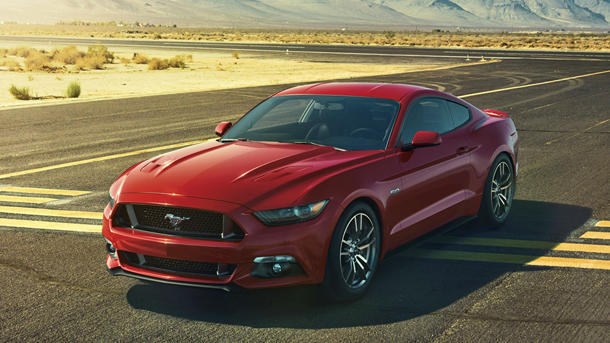 After 49 years, you would think Ford would have figured out the formula for designing a newMustang. Yet every fresh generation of the car since the '70s has drawn great concern from the fan base — and occasionally, those fears came true. This time around, Ford's corporate rule of building models for global consumption led to the most worry; would the new 'Stang lose some of its essential character while chasing new buyers?
After 49 years, you would think Ford would have figured out the formula for designing a newMustang. Yet every fresh generation of the car since the '70s has drawn great concern from the fan base — and occasionally, those fears came true. This time around, Ford's corporate rule of building models for global consumption led to the most worry; would the new 'Stang lose some of its essential character while chasing new buyers?
Here's the answer: Yes, there will be right-hand-drive Mustangs, although they'll be a small portion of total output from the Flat Rock, Mich., factory. Yes, there's a new turbo four-cylinder engine option that will hearken back to the SVO days of the '80s. And the rear suspension finally joins the 21st century, dropping the cheap solid rear axle setup as pioneered by the Model T.
But Ford engineers and designers say their overarching goal with the 2015 Mustang was to preserve all the traits that have made the name a mainstay of American roads and drag strips for five decades — not remake the formula for audiences abroad.
"We designed this Mustang to be a Mustang, to be the next generation update of everything important, and then take it global," Dave Pericak, Ford Mustang chief engineer, told Yahoo. "We didn't decide to do a global Mustang, because that would be a different product."

Under development since 2009, the biggest change comes from the outside, where the new styling reflects the arrival of an all-new chassis. Despite selling 9 million copies, the Mustang has always been something of a corporate beggar within Ford, relying on parts from other models in a bid to stay affordable. For the first time, Ford gave the Mustang its own unique chassis, although rumors around Dearborn suggest it could eventually spawn a Lincoln sedan to shoulder some overhead costs.
The new Mustang rides lower to the ground, and takes a few cues from other Fords, but the thick grille, long roof slope to a short trunklid and sequential taillights all maintain the Mustang look. Inside, the changes seem less dramatic — a touch more brightwork, a standard push-button start, and better materials, but still a 2+2 seater with a fighter-like cockpit.
"We were trying to get that right mix of Mustang-ness versus modernity," said Moray Callum, Ford's chief of design. "People that know it as a Mustang will recognize it instantly, and those that don't will still see it as a modern sports car."
Under the hood will rest one of three engines, starting with a revised version of the Coyote 5-liter V-8 which Ford says will produce more than the current model's 420 hp. and 396 lb.-ft. of torque. The base 305-hp, 3.7-liter V-6 also gets a minor tweak, but is mostly unchanged. The real news: an optional 2.3-liter EcoBoost turbo four-cylinder, which will be a mid-level engine in the United States and the base engine overseas, offering at least 305 hp and 300 lb.-ft. of torque, with the best fuel economy of any setup.
While Ford left the choice of six-speed automatic or manual transmission unchanged, it altered everything else about how that power reaches the road. The solid rear axle that Mustang loyalists so staunchly defended over the years that paid dividends at the drag strip while turning every neighborhood speed bump into a launching pad has finally given way to a modern, integral-link independent rear suspension. That allows bigger stock tires, up to a 9.5-inch wide rear wheel on the top GT. Brake discs grow as well, with up to 15-inch discs on the front.
Most of those changes would improve everyday performance, but as expected the Mustang gets better software as well. Launch control trickles down from the GT500 into the regular GT, which also gets a multi-mode driving system with settings for bad weather, normal driving and track days. All of this tech will haul less weight — although Pericak would not confirm that the 'Stang had lost as much as 200 lbs. in the new form, saying Ford was still making final adjustments before production begins.
And while Pericak wouldn't disclose any hard performance data, he did say the engineers not only used the Mustang Boss 302 as a handling benchmark for the new car, but also a few models typically not compared with a Mustang, like the Porsche 911. "We set some pretty high targets," he said.
Those targets may help the Mustang with buyers in China and Europe, where Ford will market the car for the first time. But it's in the United States, and against a revived Chevy Camaro, where the new Mustang will be judged most when it arrives in dealers sometime next autumn — and based on everything shown so far, the race between pony cars will be as close as ever.
Yahoo
Yahoo
No comments:
Post a Comment